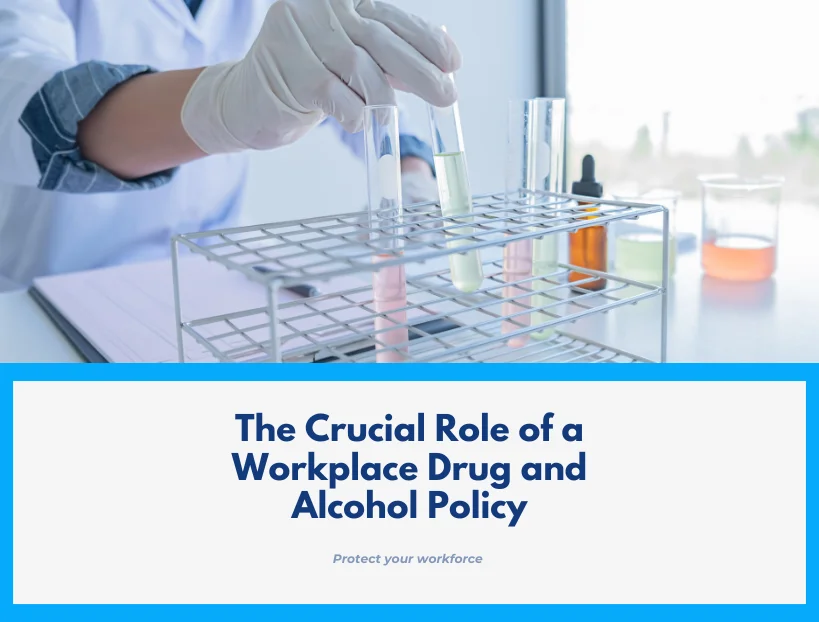The Crucial Role of a Workplace Drug and Alcohol Policy
Creating a safe and productive workplace starts with a strong drug and alcohol policy. Without clear guidelines, businesses risk safety incidents, reduced productivity, and legal complications. This is especially critical in industries with high-risk roles like transportation, construction, and manufacturing.
By implementing a clear policy, employers can promote safety, reduce risks, and comply with federal regulations, such as those set by the U.S. Department of Transportation (DOT).
Why Your Workplace Needs a Drug and Alcohol Policy
Improved Safety and Reduced Incidents
Substance misuse impairs judgment, reaction time, and coordination, increasing the risk of workplace accidents. A drug and alcohol policy helps create a safer work environment, reducing the chances of injuries and fatalities.
Regulatory Compliance
Certain industries, like transportation, are legally required to have drug and alcohol testing programs under the DOT’s guidelines. Staying compliant helps businesses avoid penalties, lawsuits, and reputational damage.
For more details on regulatory requirements, visit the DOT’s Office of Drug and Alcohol Policy and Compliance.
Enhanced Productivity
Employees struggling with substance misuse often experience:
-
Higher absenteeism rates
-
Decreased focus and efficiency
-
More workplace conflicts
A proactive policy encourages a healthy and productive workforce.
Risk Mitigation
Substance misuse leads to higher worker’s compensation claims and legal liabilities. Studies show that employees who misuse substances are five times more likely to file worker’s compensation claims.
A drug-free policy demonstrates a commitment to safety, which can help businesses lower insurance premiums and avoid costly legal issues.
Support for Employees
A comprehensive Employee Assistance Program (EAP) can provide:
✅ Confidential counseling services
✅ Substance abuse recovery support
✅ Guidance for employees and their families
Offering these resources promotes a supportive and responsible work environment.
For more insights, visit the U.S. Department of Labor’s resource hub.
Key Elements of a Workplace Drug and Alcohol Policy
A well-defined policy ensures clarity, consistency, and fairness. Here are the essential components:
Purpose
Clearly state the objectives of the policy:
-
Promote workplace safety
-
Reduce health and legal risks
-
Ensure compliance with federal and state regulations
Scope
Define who the policy applies to, including:
✔ All employees
✔ Contractors
✔ Job applicants
✔ On-site and remote workers
Responsibilities
Assign clear roles to enforce the policy:
-
Company: Develop, update, and enforce the policy.
-
Program Administrator: Oversee testing, training, and policy compliance.
-
Supervisors: Identify signs of impairment and support employees.
-
Employees: Adhere to the policy and undergo required testing.
Prohibited Conduct
Clearly define unacceptable behaviors, such as:
-
Using, possessing, or distributing drugs or alcohol during work hours
-
Being under the influence while at work
-
Misusing prescription medications without proper disclosure
Testing Procedures
Outline the different testing methods:
-
Pre-Employment Testing (screening job candidates)
-
Random Testing (preventing misuse)
-
Reasonable Suspicion Testing (signs of impairment)
-
Post-Accident Testing (determining causes of workplace incidents)
Always comply with federal, state, and local laws when implementing drug testing procedures.
Consequences of Failing a Test
Specify what happens if an employee fails a drug test:
-
Mandatory counseling or rehabilitation
-
Suspension or termination, depending on policy guidelines
-
Clear appeal process for fairness
Confidentiality and Privacy
Explain how drug test results will be:
✔ Securely stored
✔ Shared only on a need-to-know basis
✔ Used in accordance with privacy laws
Employee Education and Awareness
Provide training sessions and informational materials on:
-
The risks of substance misuse
-
Workplace safety responsibilities
-
Available support programs
Marijuana Use in the Workplace
Even though some states allow recreational or medical marijuana use, employers retain the right to enforce a drug-free workplace policy.
Best Practices for Addressing Marijuana Use:
✔ Clearly list marijuana as a prohibited substance
✔ Train managers to identify signs of impairment
✔ Stay updated on state and federal laws
Prescription Drug Safety in the Workplace
Even legal medications can impact work performance and safety. To promote safety:
✅ Educate employees on proper prescription drug use
✅ Display Prescription Drug Safety Posters in the workplace
✅ Encourage employees to disclose impairing medications for necessary accommodations
Benefits of Implementing a Drug-Free Workplace Policy
A drug-free workplace offers tangible benefits:
✔ Fewer workplace accidents
✔ Lower absenteeism and turnover
✔ Higher productivity and efficiency
✔ Reduced insurance costs
✔ Compliance with federal contract requirements
For additional resources, check out the CDC’s Workplace Supported Recovery initiative.
Take Action: Develop Your Workplace Drug and Alcohol Policy
Draft a Comprehensive Policy
Writing a custom policy can take 3-6 months. You can:
-
Assign the task to an HR or legal expert
-
Use policy templates (but customize them for compliance)
-
Utilize Smarter Risk’s Policy Builder to automate policy creation
🚀 Want to create your policy instantly? Use the Smarter Risk Policy Builder
Final Thoughts: Build a Safer Workplace Today
A workplace drug and alcohol policy is essential for safety, compliance, and productivity. By implementing a clear policy, businesses can reduce risks, support employees, and avoid legal liabilities.
Ready to create a safer workplace?
✅ Start your free risk assessment today! Visit Smarter Risk now.
